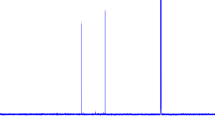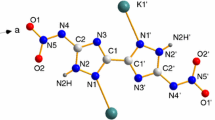Abstract
The explosive tetrazene (1-amino-1(tetrazol-5-yl-diazenyl)guanidine monohydrate) has been actively used in initiating compositions since the beginning of the 20th century, but it has low thermal and hydrolytic stability. As an alternative to tetrazene, it was proposed to use 2-(tetrazol-5-yl-diazenyl)guanidine (MTX-1), which is its more thermally stable derivative. However, a decision on the application of a particular explosive is made primarily based on its explosive properties; for tetrazene and MTX-1, these properties are not well known. The objectives of this study were to determine the detonation velocity and heat of explosion of MTX-1 in comparison with tetrazene and explain the results obtained. Calorimetric measurements were carried out in a modified steel bomb. Samples of MTX-1 and tetrazene (\(\approx\)1 g) were exploded in helium to determine the heat of explosion and the volume of gases. Experimental data on the critical detonation diameter of both substances were obtained. The detonation velocities of MTX-1 and tetrazene were determined by an electromagnetic method.
Similar content being viewed by others
REFERENCES
S. Dilun, “Study on the Explosion Reaction Equation of Tetrazene," in Proc. 17th Int. Pyrotechnics Seminar Combined with the 2nd Beijing Int. Symp. of Pyrotechnics and Explosives, 1991.
C. H. Johansson and P. A. Pearsson, Detonics of High Explosives (Academic Press, 1970).
J. W. Fronabarger, M. D. Williams, A. G. Stern, and D. A. Parrish, “MTX-1—a Potential Replacement for Tetrazene in Primers," Centr. Eur. J. Energ. Mater. 13 (1), 33–52 (2016).
B. P. Zhukov, Energetic Condensed Systems: A Brief Encyclopedic Dictionary (Yanus-K, Moscow, 2000) [in Russian].
L. I. Bagal, Chemistry and Technology of Initiating Explosives (Mashinostroenie, Moscow, 1975) [in Russian].
J. W. Fronabarger and M. D. Williams, “Alternative to Tetrazene," US Patent No. US8632643B2, Publ. No. WO/2012/003031 A2 (2012).
Q. L. Yan et al., “Multi-Stage Decomposition of 5-Aminotetrazole Derivatives: Kinetics and Reaction Channels for the Rate-Limiting Steps," Phys. Chem. Chem. Phys. 16 (44), 24282–24291 (2014).
State Standard (GOST) No. 147–95: Solid Mineral Fuel. Determination of the Highest Combustion Heat and Calculation of the Lowest Combustion Heat (Izd. Standartov, Minsk, 1995).
Ya. O. Inozemtsev et al., “Development of a State Primary Standard for a Combustion Energy Unit," Gorenie Vzryv, No. 4, 278–283 (2011).
A. I. Sumin, B. N. Kondrikov, V. N. Gamezo, and V. M. Raikova, “Shock and Detonation General Kinetics and Thermodynamics in Reactive Systems Computer Package," in Proc. 11th Int. Detonation Symp., Snowmass, Colorado USA, 1998, ONR 333-00-5, pp. 30–35.
G. B. Belov, “Thermodynamic Analysis of Combustion Products at High Temperature and Pressure," Propell., Explos., Pyrotech.23, 86–89 (1998).
L. I. Khmel’nitskii, Handbook of Explosives(Moscow, 1962), Part II [in Russian].
J. Y. Bonnet et al., “Compositional and Structural Investigation of HCN Polymer through High Resolution Mass Spectrometry," Int. J. Mass Spectrom. 354, 193–203 (2013).
J. L. Andersen et al., “Navigating the Chemical Space of HCN Polymerization and Hydrolysis: Quiding Graph Grammars by Mass Spectrometry Data," Entropy 15 (10), 4066–4083 (2013).
C. He et al., “Structural Investigation of HCN Polymer Isotopomers by Solution—State Multidimensional NMR," J. Phys. Chem.116 (19), 4751–4759 (2012).
K. K. Andreev and A. F. Belyaev, Theory of Explosives (Oborongiz, Moscow, 1960) [in Russian].
G. B. Manelis, G. M. Nazin, Yu. I. Rubtsov, and V. A. Strunin,Thermal Decomposition and Combustion of Explosives and Propellants (Nauka, Moscow, 1996) [in Russian].
Author information
Authors and Affiliations
Corresponding author
Additional information
Translated from Fizika Goreniya i Vzryva, 2021, Vol. 57, No. 3, pp. 104–110.https://doi.org/10.15372/FGV20210310.
Rights and permissions
About this article
Cite this article
Kolesov, V.I., Kapranov, K.O., Tkacheva, A.V. et al. Explosive Characteristics of Tetrazene and MTX-1. Combust Explos Shock Waves 57, 350–355 (2021). https://doi.org/10.1134/S0010508221030102
Received:
Published:
Issue Date:
DOI: https://doi.org/10.1134/S0010508221030102




